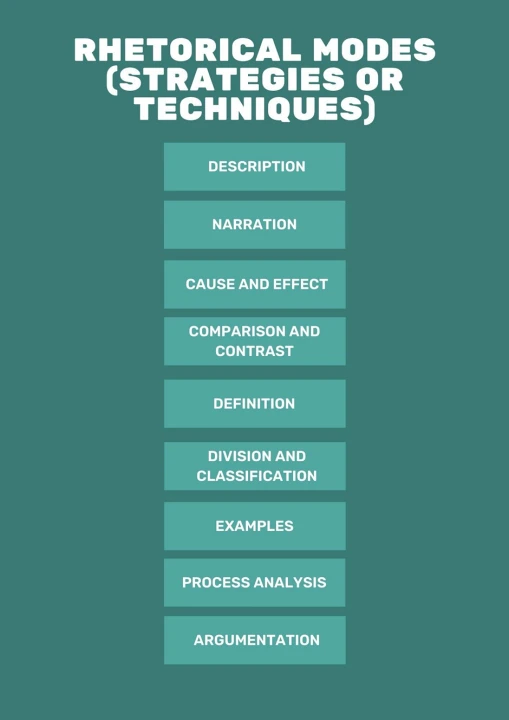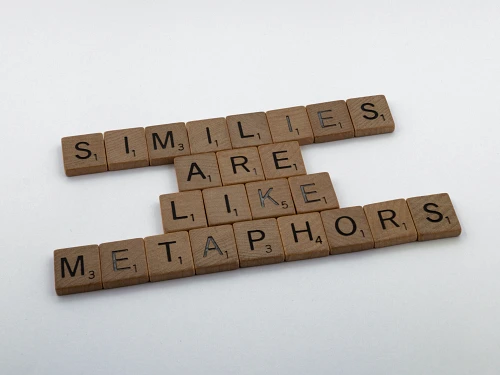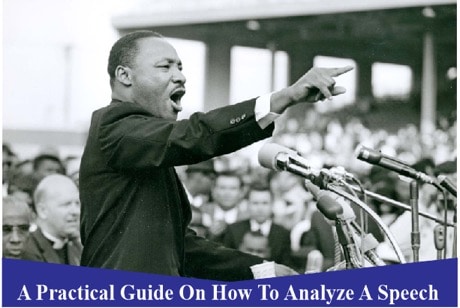RHETORIC: Definition, Types of Rhetoric, 38 Rhetorical Devices and Examples
What Is Rhetoric?
Rhetoric is the art of persuading through argumentative discourse, whether in speaking or writing, using figures of speech and rhetorical devices.
Although rhetoric started in the judicial setting as a technique of defense in courts, and although it’s mostly academically discussed now and often made famous through formal, humanitarian, or political discourses, or even through those in the area of sales, rhetoric isn’t exclusively reserved for those types of discourses.
When To Use Rhetoric?
Rhetoric is as helpful in day-to-day life as it is in politics. If you ever had to convince your parents about anything as a child, persuade a friend to go with you to a party, or if you’ve had to write a motivational letter to get into college or to get a particular job position, you’ve used rhetoric, even if unconsciously.
The 4 Rhetorical Appeals (How To Use Them)
Aristotle, the Greek philosopher and father of rhetorical studies, believed that to apply rhetoric effectively, the speaker should consider four main factors, that are the modes of persuasion:
1. Ethos
Focused on the speaker’s character, morals, role in the speech, and overall credibility.
To use it to your advantage when making a rhetorical discourse, you should create the space to introduce yourself and emphasize your competence in the subject in question. That way, the audience will be more open to hearing you as you’ve proven your credibility.
2. Pathos
Focused on the audience, their disposition, emotions, and their ability to be sympathetic with the discourse.
To use this appeal, before your discourse, before even formulating it (whether in written form or spoken form), get to know your audience, put yourself in their shoes and think of how your discourse will sound to them.
Make sure that your discourse is accessible for them to understand and that it appeals to their emotions, the kind of emotion that you wish to evoke in them. Yet, be careful not to sound or look manipulative.
3. Logos
Focused on the text of the discourse and on reason. It looks into how well the actual text is written and how logical the arguments and the conclusions (in it) are.
To use it to your advantage, put the time in formulating a concise discourse, avoid fallacies and make sure that your arguments are well-composed and clear, as those things help your audience follow and understand them.
4. Kairos
Focused on the context and timing, specifically in how suitable and timely the argument is in that specific context.
To use Kairos in your discourse, make sure your discourse is relevant for that specific context by timing it perfectly.
These factors help the speaker formulate a coherent discourse that effectively persuades the targeted audience. Considering them may help guarantee that the rhetorical argument is credible, effectively directed at the target audience (one individual or a group), and speaks on facts and events that have occurred or may occur.
From another perspective, the rhetorical appeals are also helpful in rhetorical studies, as they orientate the discourse analysis, helping scholars discern good and bad discourses from a rhetorical stance.
Highly Recommended Articles:
The First Step in Conducting a Rhetorical Analysis
The Ultimate Guide to Great Public Speaking
The Different Types of Rhetoric
Aristotle believed that all rhetorical arguments could fit and therefore be separated into three main forms:
1. Deliberative
Compares contrasting future outcomes to support or show opposition for a given action or policy.
2. Judicial
Also called forensic rhetoric, considers the justice or injustice of an argument, usually accusation or charge, since it’s used in courts by lawyers.
3. Epideictic
Consists of ceremonial discourse that usually praises or blames someone or something.
Later on it was determined that rhetoric arguments can also be divided in:
Formal
Arguments in which the ability to communicate effectively lies in the form they’re written. In this segment, they can be syllogisms (disjunctive syllogism, dilemma, and reduction ad absurdum)
Informal
Arguments that justify a conclusion without proving if it’s true or false. They can be based on examples, analogy, authority, and arguments about causes.
The 9 Rhetorical Modes (Strategies and Techniques)
Rhetorical modes are strategies used in spoken or written texts that help people organize their evidence and facts to enrich their argument and help convey it and its purpose.

There are nine main rhetorical modes:
1. Description
It gives a verbal picture of something by breaking it down into words that appeal to all the five senses and other details such as space. The word choice is usually exact verbs and nouns and adjectives that convey the vibe of the object.
2. Narration
Consists of describing an event, following a chronological order, a sequence, and sometimes, following the space. Besides the usual verbs, nouns, and adjectives, adverbs and transitional words are also used.
3. Cause and Effect
Consist of analyzing events with particular attention to why they happened and their consequences. It’s about going from past to future or vice versa, breaking down and explaining an occurrence.
4. Comparison and Contrast
Consist of showing similarities and differences between two things, whether they are concepts, objects, or even people.
5. Definition
Consists of explaining a term or concept in a way that clearly expresses its meaning and sometimes using examples.
6. Division and Classification
Is just like comparison as it shows similarities and differences between concepts, objects, and people, yet it’s applied for groups larger than two.
7. Examples
Consist of illustrating a concept or thing in hopes of building an understanding of what is being illustrated.
8. Process Analysis
Consists of explaining how something is done (“how to”) following a chronological order.
9. Argumentation
Consists of defending and refuting an idea, a concept, or a person. It’s what rhetoric is more famous for.
To get the audience invested in the discourse and successfully persuade them, speakers use specific language techniques, called rhetoric devices. Check out below a list of 38 rhetoric devices with examples.

38 Rhetoric Devices with Examples
These techniques help speakers come up with a message that’s better adjusted to the audience and that brings up the reaction that the speaker is looking for and expecting from them.
Some of the most popular rhetorical devices are (in no particular order of importance):
1. Alliteration
Consists of forming phrases with words with the same initial or initial sound. It’s used to emphasize the argument and make it memorable.
Example: “Gorgeous, gorgeous girl.”
2. Metaphor
Consists in describing an object or action in a false way to the literal description, but that serves as an excellent comparison to it. It’s used to illustrate an idea or argument.
Example: “I’m light as a feather.”
3. Comparison
Consist of associating two things in a sentence in light of their similarities or differences, generally using terms such as “like,” “as,” “then.” It’s used to emphasize an idea and make it more vivid.
Example: He plays better than I do.
4. Personification
Consists of the attribution of human characteristics to inanimate objects or things. Like metaphor, personification is also used to illustrate an idea or an argument in the discourse.
Example: The cake was calling her.
5. Climax
Consist of forming a phrase or an argument, starting from the weaker to the strongest. It’s a great way to emphasize an idea.
Example: “There are three things that will endure: faith, hope, and love. But the greatest of these is love.” 1 Corinthians 13:13.
6. Anaphora
It’s similar to alliteration; it consists of repeating a word or a whole sentence at the beginning of a clause or argument. Like alliteration, it also emphasizes the argument and makes it more memorable.
Example: “As you know, we’ve got the iPod, best music player in the world. We’ve got the iPod Nanos, brand new models, colors are back. We’ve got the amazing new iPod Shuffle.” ~Steve Jobs
7. Epiphora
Like Anaphora, it also involves repeating a word or phrase, yet at the end of the sentences. Its purpose is to emphasize.
Example: From the famous Oprah moment “You get a car, you get a car, you get a car, everybody gets a car!”
8. Symploke
Consists of combining one or more Anaphoras with one or more Epiphoras in an argument. The purpose is also to emphasize.
Example: “For want of a shoe the horse was lost. For want of a horse the rider was lost. For want of a rider the battle was lost. For want of a battle the kingdom was lost.”
9. Germinatio
Consists of repeating one word or a group of words in one argument.
Example: “I’ll miss you every second of every hour of every day.”
10. Anadiploses
Consists of repeating the last few words of a phrase, in a new one, right after the original sentence.
Example: “She knew something, something that would change their lives.”
11. Asyndeton
Consists of forming a phrase with a sequence of words or similar expressions without using conjunctions.
Example: “I came. I saw. I conquered.” Julius Caesar.
12. Polysyndeton
Consists of repeating, multiple times, the same conjunction (mostly “and”) in a sentence or argument. It’s a way of connecting different words, sentences, and ideas in the same sentence. It can be used for practical purposes, when enumerating things, or for artistic purposes, especially in literature).
Example: “I want a coffee, and a cake, and a cookie, and a teaspoon of sugar, and a piece of caramel.”
13. Interrogatio
It’s another name for the popular “rhetorical question,” which is, in essence, a question that doesn’t require an answer because the response is implied in the question. It’s used to confirm or reinforce what was previously said.
Example: “Oh, you’re laughing?! You think this is a joke, huh?”
14. Exclamatio
It’s a highly passionate and emotional exclamation. It expresses and showcases the speaker’s emotional involvement with the argument.
Example: “Oops!”
15. Aporia
Consists in (the speaker) feigning doubt or uncertainty in the form of a statement or question in an argument. It helps make a point.
Example: Elizabeth Barrett Brown’s poem “How do I love thee?”
16. Hyperbole
Consists of making an obvious exaggeration in the form of a statement that isn’t meant to be taken literally. It’s used to make something bigger than it actually is and for dramatic purposes.
Example: “I could die of laughter right now.”
17. Simile
Consists of comparing two things of a different kind, often using “as” or “like.” It’s used to illustrate an idea.
Example: “You’re sweet as candy.”
18. Antitheton
Consists of forming a statement with two opposite or contrasting facts. It’s similar to antithesis, yet it’s not limited to just the opposition of words. It’s on a grander scale because it deals with opposite ideas.
Example: “It was the best of times; it was the worst of times.”– Charles Dickens, Tale of Two Cities.
19. Slogans
Just like the popular understanding of it, in rhetoric, it also consists of one phrase or statement that is taken as a “brand” and repeated often. It’s useful because it’s memorable.
Examples: Nike’s “Just do it.” or MacDonald’s
20. Hypophora
Consists of posing a question and immediately following it with the answer. It helps bring the audience’s attention to the argument and helps establish the speaker’s authority.
Example: “Should you be concerned? Not at all.”
21. Antanagoge
Consists of presenting the audience with a negative fact and then following it with a positive one. It’s often used in the form of a problem followed by a solution. It serves to connect with the audience and persuade them to follow the speaker’s idea, since often, when confronted with the problem, the audience runs to think of possible solutions. When that coincides with the speaker’s solution, it motivates agreeableness.
Example: “They tried to bring us down, yet still we rise “
22. Cacophony
Consists of using a combination of words with harsh and loud sounds. It works when trying to instigate the audience.
Example: A mixture of sounds like people talking, music, traffic, and general everyday sounds.
23. Epizeuxis or Antanaclasis
Consists of repeating a word twice in a phrase but with a different (or opposite) meaning at the second repetition. It’s useful when communicating different ideas or when comparing things.
Example: “Books.Books.Books.”
24. Diacope
Similar to repetition, it consists of repeating a word or phrase, only with a few words intervening in each repetition. It serves the same function as repetition, emphasizing an idea.
Example: “Happy families are all alike; every unhappy family is unhappy in its own way.”
25. Antithesis
It’s when you introduce opposite and contrasting prepositions in your discourse. It’s used to highlight the difference between ideas, to show the best idea in an obvious way.
Example: “That’s one small step for man, one giant leap for mankind.” – Neil Armstrong
26. Auxesis
Consists of using forms of increase, namely hyperbole (which we have previously defined), climax (which is a combination of ascending statements), and amplificatio (which is the excessive repetition of one statement). They all emphasize an argument by exaggeration since that tends to affect human perception.
Example: “Was it possible they heard not? Almighty God! – no, no! They heard! – they suspected! – they knew!”— (“The Tell-Tale Heart,” 5:94)
27. Amplification or Pleonasm
Amplification has to do with all the ways we can expand and enrich an argument or discourse. Pleonasm, in particular, consists of using more words than necessary to emphasize what’s being said or for stylistic reasons.
Example: “I feel sick. I have a terrible headache, my nose has been runny, and I think I have a fever.” -Amplification;
A verse in Jhené Aiko and Big Sean’s song “It’s Deja vú, cause I’ve been here with you.” -Pleonasm.
28. Apophasis
It’s about bringing up a subject by denying it or denying it should be mentioned. The typical claiming that you won’t say something by saying it. People use it almost every day.
Example: phrases like “Not to mention that…”, “Let’s not (even) talk about how…”, “We won’t discuss the fact that…”.
29. Diasyrmus
Consists of rejecting an adversary’s argument by use of disdain (through examples) as a means of poking fun of what he said.
Example: “Saying yes to this is like shooting yourself in the foot.”
30. Derision
Generally means mockery, yet it’s not regular mocking. It consists of mocking someone to the point where you even discredit them completely.
Example: Most of the “Yo Mama” jokes.
31. Enthymeme
Enthymeme is one informal rhetorical syllogism (group of phrases from which we can draw a conclusion from) with an implied premise. Unlike other syllogisms where the conclusion is clearly stated, it’s only implied here.
Example: “I don’t trust him. He backstabbed his best friend.”
32. Innuendo
It’s a suggestion about something or someone, not made explicit. It is said politely, yet the actual unexplicit meaning hints at something unpolite.
It’s very similar to euphemism, but innuendos are derogatory, while euphemisms seek to replace offensive words with less offensive ones.
Example: “Relax, I’m sure we will pass the test. I told you I have ‘extra help.'” suggesting cheating.
33. Metanoia
Consists of recalling a previous statement to either weaken it or strengthen it.
Example: “To put it a better way…”; “More properly thinking…”
34. Procatalepsis
Consists of raising an objection to the argument and responding to it; in that way, you anticipate any counter-arguments that your listener might have and refute them even before they have the chance of raising them.
Example: “I know you said I can’t have candy at night…”
35. Understatement
Consists of intentionally downplaying a situation or matter to a point where it doesn’t seem as important as it truly is. People use this when they know that the situation may come with harsh consequences or panic.
Example: If you crush your car against another harshly, but when telling the story to people, you say, “We just touched a little bit.”
36. Irony
Consists of contradictions (in statements and situations) on a surface level that hide a radically different reality of the situation.
Example: There was a social media trend that was very popular, mocking things by saying
things like “Get a dog, they said. It’ll be fun, they said.” while showing images of dogs ruining their owner’s things or misbehaving.
37. Metonymy
It consists of replacing a name (of an object or concept) with a name of something related to it, but that doesn’t reveal the actual object or concept.
Example: “He is part of the crown.” being that crown is referring to the royal family.
38. Synecdoche
Consists of using one part of something to represent and signify the whole of that thing.
Example: The expression “hired hands” refers to workmen.
-
The 4 Methods or Types of Speech Delivery

On a daily basis, people use several types of speech delivery to connect with others, influence decisions, and motivate change without realizing which occasions a specific method of speech delivery should be used. Today we will talk about 4 types of speech delivery that are commonly used and sometimes happen almost unnoticed. Manuscript Speech Memorized…
-
A 9-Step Practical Guide On How To Analyze A Speech – Speech Analysis of I have A Dream Speech as an Example

A speech, as we all know, is a vocal opinion of a speaker’s stand. Speeches are usually used as an effective tool for rallying support, conveying opinion, as well as influencing the thoughts of others (usually the audience) to accept or agree with the thoughts of the Speaker. For a speech to achieve its goal,…
-
An Easy Guide to All 15 Types of Speech

We keep learning that there are three types of speeches, informative speeches, persuasive speeches and special occasion speeches. However, I believe and know that there are many more such as debates, motivational speeches, forensic speeches, impromptu speeches, eulogy, and so on. Here’s a growing list of over 13 types of speech and tips on how…
Real Life Examples of Rhetoric
Politics is the field where we have the most examples of both good and bad sides of rhetoric and how they affect the whole. The difference between good and bad rhetoric being the intention behind why people are applying these methods.
A few recent examples of bad rhetoric are the speeches of the former President of the USA, Donald Trump. He gave many controversial speeches, but because of his application of rhetoric, was able to convince people that he was the right candidate to elect.
In contrast, on the good side of rhetoric is another former President of the USA, Barack Obama, whose speeches have motivated many people and inspired a lot of positive change.
They both were excellent in rhetoric, the only difference being their motivations and purpose. Yet that difference was so significant that it separated their speeches and discourses in two completely different categories.
How To Improve Your Rhetoric
To improve your rhetoric, try to develop the following skills:
Good Communication Skills
That way, you will be able to pass the message you intend to pass effectively.
Emotional Intelligence
That way you’ll be able to have control of your emotions, knowing which ones to display and when, and which ones to guard, also depending on the context.
Negotiation Skills
Since rhetoric is mainly used in negotiation-like scenarios. If you don’t possess any negotiation skills, don’t worry because this skill can also be acquired with time as you work on your rhetoric and improve it.
Active Listening Skills
Since you also need to consider your listeners’ point of view. This skill also leads to another important one, Empathy, which is very similar to it and serves to make the listener feel seen while allowing you to understand him.
Self-awareness
So you can recognize your strong points, and therefore use them in your favor, as well as your weak points, so you can work on them, with them and possibly eliminate them.
Logic and Reasoning
Practice logical thinking and using reason to form coherent thoughts and discourses that will benefit you (and hopefully other people too).
Make sure that you keep learning about rhetoric by looking deeper into everything that Aristotle and other authors have said about it. If you don’t know where to start, don’t worry, I’ve crafted a list with the three most popular or just popularly mentioned books on this subject:
Books That Will Help You Improve Your Rhetoric and Persuasion Skills
The Art of Rhetoric by Aristotle
The best way to learn about rhetorics is through the father of rhetoric himself, Aristotle.
This book is a guide to rhetorical principles and the principles of oral discourse in general by the person who developed Rhetoric.
Verbal Judo: The Gentle Art of Persuasion, by George J. Thompson and Jerry B. Jenkins
Number three on Amazon’s bestseller list on this topic. It’s a handy guide that observes conflict, guides you to look at it in a better and less aggressive way, and gives you tips on inspiring cooperation from people in diverse contexts.
Thank You for Arguing: What Aristotle, Lincoln, and Homer Simpson Can Teach Us About the Art of Persuasion, by Jay Heinrichs
It’s a humorous guide with rhetorical techniques from Cicero’s time to the modern days, not only for people interested in this area or in language in general but also for anyone who wants to learn how to win arguments without drama.
Finally, make sure that you prepare speeches keeping in mind everything you’ve learned about rhetoric and that you listen to speeches and discourses from an analytical point of view of someone who possesses rhetorical knowledge.
Further Readings
How to Write Persuasive Rhetoric: 6 Tips for Persuading an Audience – 2022 – MasterClass








